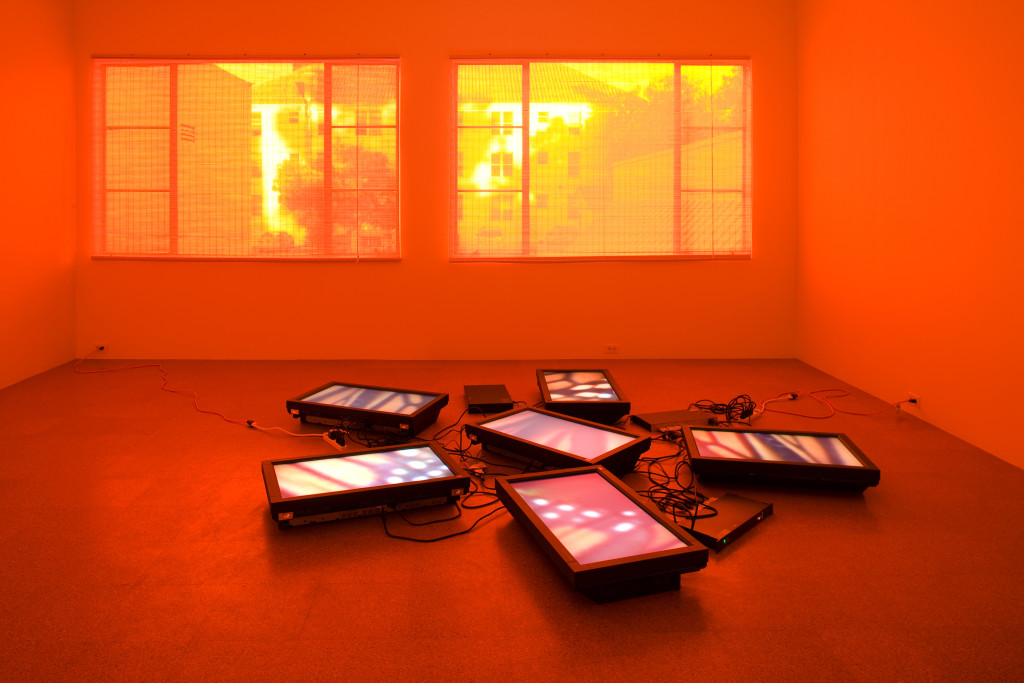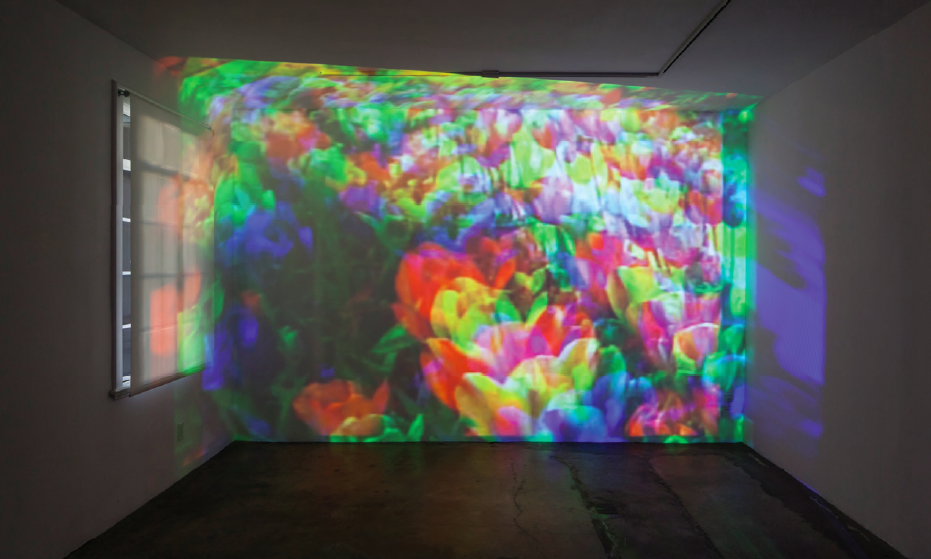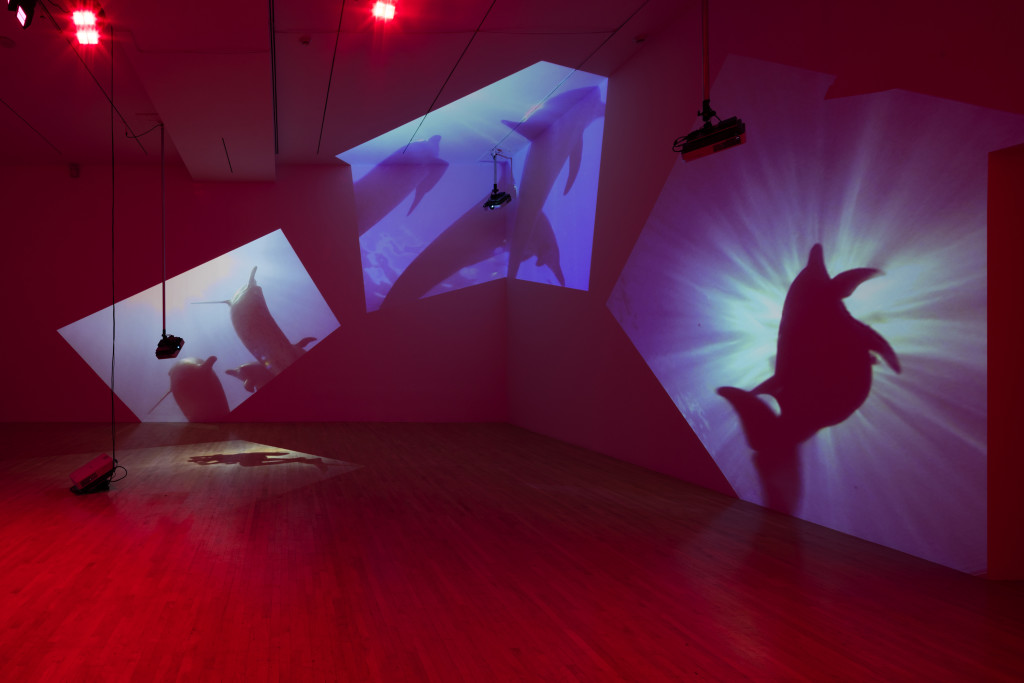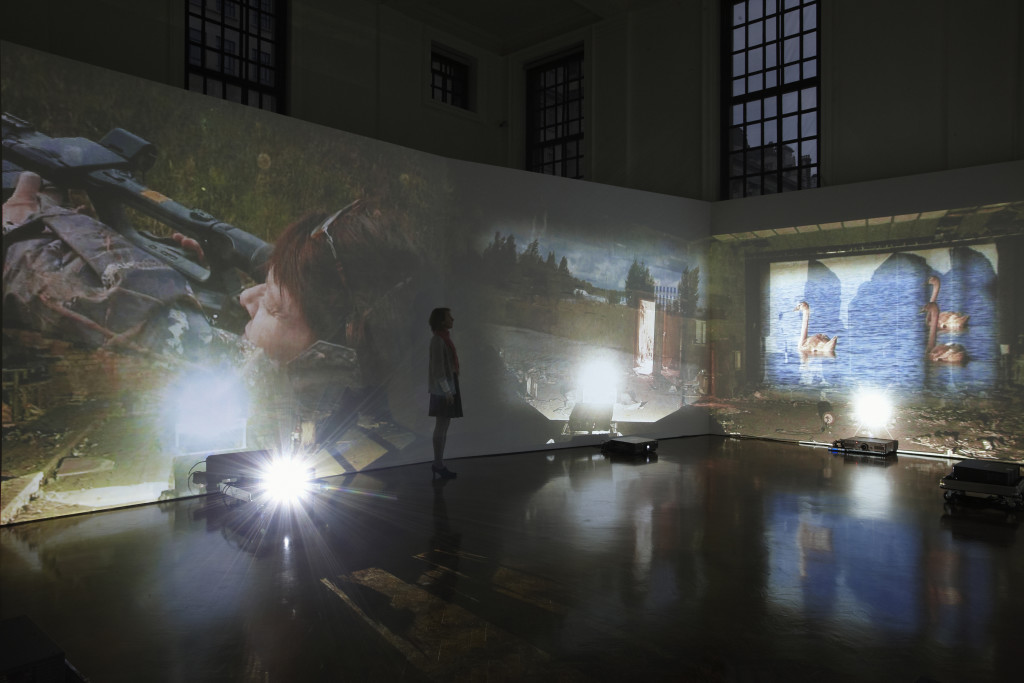Diana Thater: The Sympathetic Imagination // Profile of the Artist
by Noah Hanna

A group of divers drop into the water; greens and blues wash over the gallery’s walls, floor, and ceiling as the camera sinks below the surface of the waves. Quick yet calculated shots project a pod of dolphins and an enamored film crew in tow. Diana Thater’s film and installation Delphine (1999), like much of her work, is as much about capturing the aesthetic beauty of nature as it is a deeply attentive discourse into the multitude of perspectives which encompass the Anthropocene. Moving through her installations, viewers find themselves in places and with beings that feel intrinsically connected, but whose presence you have yet to completely embrace. Instead, Thater offers dualisms in her work—an acute awareness of the present, as well as an acceptance of the constraints of human perception. A moment of conscious clarity and a sympathetic bond to creatures whose perception of time exists outside of our broadest imaginings.
In April, Diana Thater concluded the first stage of her mid-career retrospective The Sympathetic Imagination (2016) at the Los Angeles County Museum of Art; the exhibition now traveling to the Museum of Contemporary Art in Chicago for its October opening. Surveying her film and installation work from the early 1990s up to Life is a Time-Based Medium (2015), the exhibition casts Thater as not only an adept filmmaker but also as an artist with a remarkable awareness of space; a capability that becomes increasingly essential when organizing the volume of work and locations that have become synonymous with the contemporary retrospective. While categorizing Thater as a filmmaker seems appropriate in the most general sense, I’ve found that the title may be constrictive when attempting to place her work in The Sympathetic Imagination. Thater’s projections are immeasurable, free of narrative cinematic intentionality and devoid of the tropes of classical or even conceptual filmmaking, but rather they are moments of silent meditation.“Thater is influenced by structuralism and what you can do with the medium rather than narrative filmmaking,” says Joey Orr the Andrew W. Mellon Curatorial Fellow at the MCA, who is organizing the Chicago exhibition, “She’s interested in making and thinking of film and video as form.”

A conscious activist for environmental protection and preservation, Thater recognizes the complexities to that title—demonstrating how these capacities of engagement become interrelated with that of an artist. In both positions, she continues to examine the roles humans play on the planet, as both actors and observers. A fair conclusion may find that the act of simply looking may be the purest form of kinetic conservation for the natural world.
As The Sympathetic Imagination makes clear, despite its staggering scale and color, viewers never lose sight of the gallery setting. And purposefully so—in Thater’s exhibition, while the space exists in an altered state, the museum walls continue to stand tall, projectors and lengths of wire are intentionally visible. It’s rather nature that permeates into the human sphere, rather than the opposite of which we have become painfully apathetic to. Within Thater’s work, a meditative collision occurs between our human occupied space and the wild; from the soft flower petals of Monet’s garden to the melancholy landscapes of Chernobyl. There can be no denying this changing landscape, nor can we harken back to a former state of wildness—rather, it is within this synthesis that Thater sees a beauty in itself.
Noah Hanna: In April, you concluded the first stage of your mid-career retrospective at the Los Angeles County Museum of Art. What was that experience like for you?
Diana Thater: It was wonderful. I have installed many exhibitions, but this was by far the largest that I have ever done, seeing that it is a retrospective. I am sure it is going to go the same way in Chicago, I can see that it is already going really well.
NH: And the transition from LACMA to the MCA?
DT: It is difficult because I am going from one exhibition space—which is designed in a certain way, and for which I designed the show—into a space that I did not know about when I had originally mapped out the installation. The Chicago exhibition came on after the first iteration was developed; I had to redesign it to fit into the MCA. It is going to look completely different—while it will contain most of the same work, the layout is obviously totally different. The one thing we were able to maintain was that at LACMA the show was set up in two parts; and at the MCA we were able to do that again, separating the two chunks of the show into two spaces on the same floor.
NH: In the past, you have said that you prefer to use pre-existing architecture over fabricating a new space. When you go into a space, do you prefer to have an ideal vision, or is this something you prefer to conceive of more spontaneously?
DT: Usually, there is a brand new piece that I am putting into a space for the first time. I much prefer to experience the space, and to be able to play with the work when I go to install. That said, a retrospective is something that you do not want to play with; you do not want spontaneity when installing a show of this size. You want it figured out to the last inch. While I need flexibility with something like moving projectors a little bit to the left or right, I did not want total flexibility—it simply would not have been possible.

NH: Tell us more about the title of the exhibition, The Sympathetic Imagination—
DT: It is a quote from one of my favorite books, “Elizabeth Costello” by J.M. Coetzee. It says, “There is no limit to the extent to which we can think ourselves into the being of another. There are no bounds to the sympathetic imagination.” It means that we have the ability to have sympathetic relationships to other beings that are both bodily and physical, which can lead to the emotive and intellectual. But it begins with the body. That is what I am really interested in—kinds of physical, sympathetic responses to other living beings. Those living beings in my work are presented in film and video installations; but the installation is designed around the viewer’s presence in the exhibition space. In other words, in terms of size, the arrangement, editing, and motion—everything is designed to allow a kind of response from the viewer that I see as sympathetic to the beings that are represented in the work. Like the dolphins or the bees, or the horses in Chernobyl.
NH: Your work aims to make viewers conscious of the space they are in, yet the locations depicted in your work are often very far from a traditional gallery setting. Can you expand on this connection, between the immediacy of a conscious space and its extension far outside that worldview?
DT: Yes—I am interested in overlaying spaces, such as positioning Chernobyl onto a museum space. There’s an interesting simultaneity of the two spaces. The viewers are conscious of what Chernobyl is, what it looks like, what it feels like; and also simultaneously being fully present in the museum and knowing they are experiencing a representation and physicalization of an image. A kind of twin consciousness: the reality of this distant place, and the reality of where you are when you are looking at it. It is the same with Life is a Time Based Medium (2015) which is a temple that I filmed in India where a troupe of monkeys lives. The temple is overlaid on the gallery space with a theatre element as well. While you know you are in a museum, you experience the space, the proportions of the building, the thickness of the walls; all of those things you experience are simultaneous with the imagery of this temple. So becomes two places at the same time. And that is a complicated phenomenon—that is it possible to think and feel the two places at the same time.
NH: Animals and the entire Anthropocene in general are a critical focus of your work—you have paid attention to what it means to be wild, and have worked both with trained, and non-domesticated animals. I often feel that filmmaking has a directorial organization to it, that things are laid out in a plan. How do you balance between the kind of innate organization in film, and the unpredictability that comes with nature?
DT: People who make film about the natural world, or about the wild or about animals, usually try to make it understandable from a human perspective. What I would prefer to do is to let it be the way it is, and to not try and fit it into our understanding of the world. In other words, when you see something like a National Geographic documentary about gorillas or dolphins, they tell you a story. They always give you something to latch on to, a kind of narrative. But the reason I chose to work with animals, nature, and the imagery of the wild is because they are inherently non-narrative. Nature has different kinds of time; not a beginning, a middle, and an end. There is circular time, parallel time, dimensions beyond the three we comprehend—there are all kinds of different ideas of time in nature. Human beings do tend to live their lives narratively. We see our lives as having beginnings, middles, and ends. We see peaks and valleys, achievements, and low points—all kinds of things that mark the times in our lives. We do not know if animals see their lives that way. It must be that they see their lives in ways that we cannot perceive. Though, by not attributing narratives to my films, I am trying to give animals space to express their being and not impose a kind of being on them.

NH: Is that why you ultimately stopped using domesticated animals in your work, such with as the wolves in your piece China (1995)?
DT: Well, I have worked with some domesticated animals, but really just horses. Those were trained wolves, but of course they are not domesticated. They are wild animals; I have worked with trained animals a few times, such as falcons who are all trained but are simultaneously wild. I am interested in the relationship that humans construct with animals when they train them, when they become companions. I do not believe there are any animals or places that are truly wild anymore. Everything is inscribed by the human; and everything, if you think about the Anthropocene, has been transformed by human intervention. I am interested in the places where those things crash together—where intervention and the wild meet one another.
Chernobyl is kind of a perfect negative example, and most of them are negative examples. There is this territory called the “Exclusion Zone” that has been completely destroyed, irradiated, and poisoned by human beings, and animals are struggling to live there. They are trying to survive in a place that has been completely inscribed by human beings, the radiation like a physical map over the space, and the animals are within that space trying to live and needing to thrive.
NH: Humans make very fleeting appearances in your films—for the most part they are exclusively focused on animals. As a viewer, what perspective would you want someone to take? Should they see your work as an animal, as a human observer, or something else?
DT: There are actually lots of people in my work—the crew is always in it, I am always in it. In Delphine (1999), you see the crew swimming around the dolphins filming them. In Chernobyl (2011) you see people with cameras everywhere. There are possibilities for you to identify with the people in the films who are doing the looking—mainly the film crew and the artist herself. I do not want people to identify with animals. I think anthropomorphism is weird. It is for little kids to pretend they are dolphins or run around among the bees in the bee piece. Adults do not do that, adults have a more distracted and sometimes considered relationship with the natural world. It is sometimes inhibited as well—my intention is not to inscribe your relationship to the natural world, I want to open it up.
NH: While your work is much more meditative and contemplative, you are someone who is actively concerned with wildlife and environmental preservation. How do you engage with what you would consider traditional activism and your artwork?
DT: I have an activist side of my life. I worked for the Dolphin Project for 10 years. I made a documentary called Welcome to Taiji (2004) with dolphin rights activist Ric O’Barry. We tried to stop the capture and slaughter of cetaceans, particularly the slaughter of dolphins and whales in Taiji, Japan, which happens for several months every year. The documentary inspired the film The Cove (2009) which won the Oscar for Best Documentary in 2010. Right now I am working on another short film about elephant poaching in Kenya. So there is an activist side to my practice and an artistic side. And I prefer to not to mix them and to keep them separate. I do not want my artwork to be overlaid with activist rhetoric; I want to put that where it belongs, and where it gets the most traction, which is with the documentary pieces.